What we learn from multi-planet systems
Wei Zhu (祝伟)
Planet Group Meeting
Tsinghua University
2021 March 5th


Zhu & Dong 2021, ARAA in press (arXiv:2103.02127)
Solar system as an example

- Planets have diverse properties (\(\sim10^2\) in separation and \(\sim10^4\) in mass).
- Planets have small but substantial orbital eccentricities (\(\lesssim0.2\)) and mutual inclinations (\(\lesssim 6^\circ\)).
- Solar system was once dynamically active, and may become chaotic again in \(\sim\) Gyr timescale.

Image credit: iLectureOnline
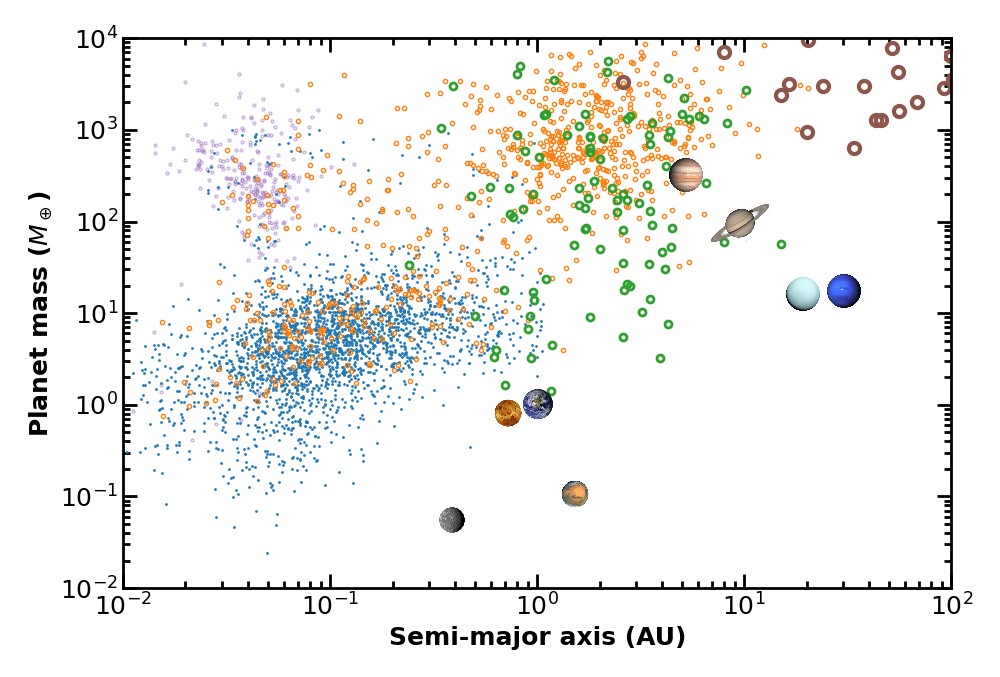
Transit (ground)
Transit (space)
RV
Microlensing
Imaging
Based on data from NASA Exoplanet Archive.
Hot Jupiters
Cold Jupiters
Super Earths
Cold Neptunes
Sub-Earths
What You See Is Not What You Get!
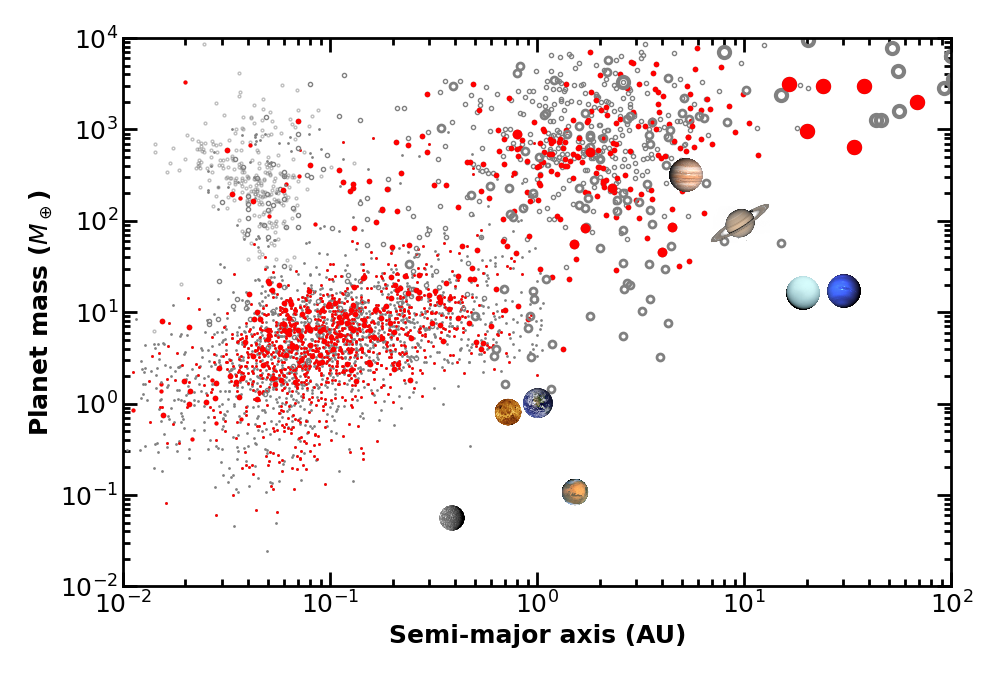
w/ known companions
w/o known companions
Based on data from NASA Exoplanet Archive.
Hot Jupiters
Cold Jupiters
Super Earths
Cold Neptunes
Sub-Earths
- Exoplanets frequently reside in multi-planet systems.
- Planets inside the same system may have formed and evolved in a correlated way?
1. Orbital properties of planets in the same system are correlated.

- No strong preference for mean-motion resonances (e.g., Lissauer et al. 2011, Fabrycky et al. 2014).
- Spacing depends on multiplicity.
- ~80-90% of Kepler planet pairs do not allow intermediate planets (e.g., Fang & Margot 2013).
- Kepler systems are dynamically packed (e.g., Pu & Wu 2015). However, interior/exterior planets remain allowed.
Spacing in mutual Hill radii
Orbital eccentricity depends on multiplicity
- The transit duration method $$ \frac{T}{T_0} = \sqrt{1-b^2} \frac{\sqrt{1-e^2}}{1+e\sin{\omega}} $$ where \( T_0 \propto P^{1/3} \rho_\star^{-1/3} \).
- Transit singles have \(\sigma_e\approx0.3\), whereas transit multis have \(\sigma_e\approx0.05\) (Van Eylen et al. 2015, 2019, Xie et al. 2016, Mills et al. 2019).
Transit duration \(T\)
Orbital eccentricity depends on multiplicity
- The transit duration method $$ \frac{T}{T_0} = \sqrt{1-b^2} \frac{\sqrt{1-e^2}}{1+e\sin{\omega}} $$ where \( T_0 \propto P^{1/3} \rho_\star^{-1/3} \).
- Transit singles have \(\sigma_e\approx0.3\), whereas transit multis have \(\sigma_e\approx0.05\) (Van Eylen et al. 2015, 2019, Xie et al. 2016, Mills et al. 2019).
-
Systems with more planets have smaller eccentricities and are dynamically colder.
- RV planets show a similar behaviour (e.g., Limbach & Turner 2015, Zinzi & Turrini 2017).

Transit singles
Transit doubles
Transit triples
Transit quadruples
Based on DR25 MCMC parameters and Berger et al. (2020) stellar parameters.
Eccentricity also shows multiplicity dependence

Transit singles have \(\sigma_e\approx0.3\), whereas transit multis have \(\sigma_e\approx0.05\) (Van Eylen et al. 2015, 2019, Xie et al. 2016, Mills et al. 2019).
Transit duration \(T\)
Eccentricity also shows multiplicity dependence


Based on DR25 MCMC parameters and Berger et al. (2020) stellar parameters.
Systems with more planets have smaller eccentricities and are dynamically colder.
- RV planets show a similar behaviour (e.g., Limbach & Turner 2015, Zinzi & Turrini 2017).
Transit singles
Transit doubles
Transit triples
Transit quadruples
Measure mutual inclinations in transit

- The weighted transit duration ratio (Steffen et al. 2010).
\( \xi \equiv \frac{\rm (Transit~chord~length)_{in}}{\rm (Transit~chord~length)_{\rm out}} = \frac{T_{\rm in} P_{\rm in}^{-1/3}}{T_{\rm out} P_{\rm out}^{-1/3}} = \sqrt{\frac{1-b_{\rm in}^2}{1-b_{\rm out}^2}} \)
Transit chord length = \( 2\sqrt{1-b^2} = v \cdot T \)
\(b\)
Measure mutual inclinations in transit

- The weighted transit duration ratio (Steffen et al. 2010).
- Mutual inclination disperson \( \sigma_i\sim 3^\circ \) (e.g., Fang & Margot 2012, Fabrycky et al. 2014).
- A lower limit.
\( \xi \equiv \frac{\rm (Transit~chord~length)_{in}}{\rm (Transit~chord~length)_{\rm out}} = \frac{T_{\rm in} P_{\rm in}^{-1/3}}{T_{\rm out} P_{\rm out}^{-1/3}} = \sqrt{\frac{1-b_{\rm in}^2}{1-b_{\rm out}^2}} \)

Weighted transit duration ratio \(\xi\)
Observed \(\xi\) distribution
\(\sigma_i=0\)
\(\sigma_i=1.8^\circ\)
\(\sigma_i=6^\circ\)
Coplanarity \(\longrightarrow\) Kepler dichotomy?

Figure from Ballard & Johnson (2016)
- With a fixed mutual inclination distribution, at least two different populations of planetary systems are needed.
- Regardless of the intrinsic multiplicity distribution (e.g., Lissauer et al. 2011, Johansen et al. 2012, He et al. 2019).
-
Transit method cannot constrain the mutual inclination because of the degeneracy with intrinsic multiplicity.
- Transit + RV (Tremaine & Dong 2012, Figueira et al. 2012).
- Transit + TTV (Zhu et al. 2018).
Mutual inclination also depends on multiplicity

Transit doubles
Transit triples
Transit quadruples
\( \xi = \frac{T_{\rm in} P_{\rm in}^{-1/3}}{T_{\rm out} P_{\rm out}^{-1/3}} = \sqrt{\frac{1-b_{\rm in}^2}{1-b_{\rm out}^2}} \)
- Weighted transit duration ratio
-
Systems with more planets have smaller mutual inclinations and are dynamically colder.
- E.g., Zhu et al. (2018), He et al. (2020).
- Fewer-planet systems are dynamically hotter.
- Each system has on average 3 planets (average multiplicity).
- Dynamical evolution may have reshaped the architecture.
Zhu et al., 2018
(see also He et al. 2020)
Intrinsic architecture of the inner (\(<1\) AU) system
\( \sigma_i,~\sigma_e \propto k^\zeta \)





Planet-planet mutual inclinations affect the frequency of planetary systems
Coplanarity \(\longrightarrow\)>50% of Sun-like stars have Kepler-like planets (e.g., Fressin et al. 2013, Petigura et al. 2013).







mutual inclination

Planet-planet mutual inclinations affect the frequency of planetary systems

- Fraction of Sun-like stars with Kepler-like planets is ~30% (Zhu et al. 2018).
- Fraction of Sun-like stars with planets in an extended parameter space may be higher (e.g., Mulders et al. 2018, He et al. 2020).
- Or not, if planet occurrences are strongly correlated.


(Colors mean different multiplicities.)
1. Orbital properties of planets in the same system are correlated \(\longrightarrow\) Dynamical evolution may have largely reshaped the system architecture.
2. The existences of planets in the same system are correlated.
Cold Jupiters
Super Earths
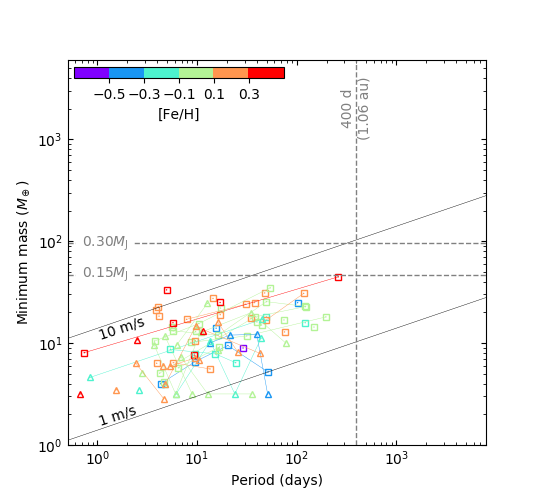
22 from Kepler (triangles) + 39 from RV (squares)
Inner-outer correlation


Kepler-48 as an example
\(M_{\rm b}=3.9\pm2.1\,M_\oplus\)
\(P_{\rm b}=4.78\) d
\(M_{\rm c}=14.6\pm2.3\,M_\oplus\)
\(P_{\rm c}=9.67\) d
\(M_{\rm d}=7.9\pm4.6\,M_\oplus\)
\(P_{\rm d}=42.90\) d
\(M_{\rm e}=2.1\pm0.1\,M_{\rm J}\)
\(P_{\rm d}=982\) d
Cold Jupiters
Super Earths
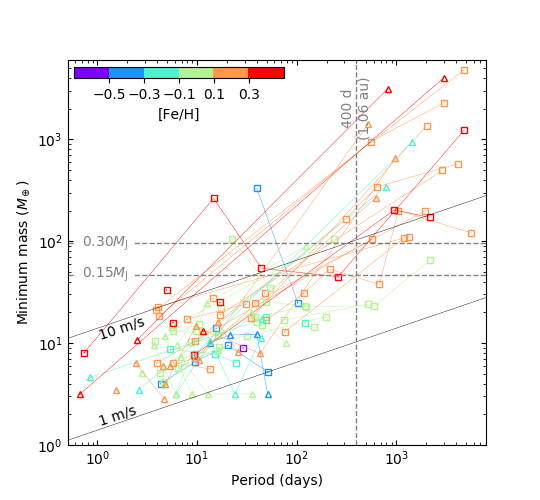
22 from Kepler (triangles) + 39 from RV (squares)
-
1/3 of Kepler systems have cold Jupiter companions.
- >50%, if [Fe/H]>0.
Inner-outer correlation
- Cold Jupiters (almost) always have inner super Earth companions!
\( P({\rm SE}|{\rm CJ}) \cdot P({\rm CJ}) = P({\rm CJ}|{\rm SE}) \cdot P({\rm SE}) \)
\( \rightarrow P({\rm SE}|{\rm CJ})=100\% \)
Cold Jupiters
Super Earths

22 from Kepler (triangles) + 39 from RV (squares)
-
Super Earths preferentially have cold Jupiter companions $$ P({\rm CJ}|{\rm SE}) \approx33\% $$
- \( P({\rm CJ})=10\%\) (Cumming et al. 2008).
- \(P({\rm CJ}|{\rm SE})>50\%\), if [Fe/H]>0.
- Cold Jupiters almost always have inner super Earth companions $$ P({\rm SE}|{\rm CJ})=\frac{P({\rm CJ}|{\rm SE}) \cdot P({\rm SE})}{P({\rm CJ})} \approx100\% $$
Zhu & Wu (2018), Bryan et al. (2019)
Inner-outer correlation
Independent confirmations
-
Long-period (\(>2\,\)yr) transiting planets frequently have inner transiting companions.
- Herman, Zhu & Wu (2019); Masuda, Winn, & Kawahara (2020).
-
TESS detections of super Earths in RV cold Jupiter systems.
- pi Mensae (Huang et al. 2018, Gandolfi et al. 2018), HD 86226 (Teske et al. 2020)
- TESS + Gaia.

2 yr
Figure from Herman, Zhu & Wu (2019)
Strong inner-outer correlation challenging formation models of Kepler planets
-
Migration models typically expect anti- or no correlations:
- Formation-and-migration (e.g., Bern model, Schlecker et al. 2020).
- Migration-then-assembly (e.g., pebble accretion, Izidoro et al. 2015, Bitsch et al. 2019).
- In situ?

Pebbles (\(\sim\) cm)
Pebble isolation mass (\(\sim10\,M_\oplus\))

See reviews by Ormel (2017), Liu & Ji (2020)
On the Poisson process assumption
- Fraction of stars with Kepler-like planets ~30%.
- Fraction of stars with cold giants ~10%.
-
Fraction of stars with planets in the joint parameter space?
- 37% [\(=1-(1-30\%)\times(1-10\%)\)] under the Poisson assumption.
- ~30%, because of the strong correlation.

Figure adapted from Penny et al. (2019)
2. The existences of planets in the same system are correlated \(\longrightarrow\) Planet formation is a global behaviour.
3. Physical properties of planets in the same system are (largely) not correlated.

Peas in a pod?

(See also Lissauer et al. 2011, Ciardi et al. 2013, Millholland et al. 2017)
Radius of the inner planet \(R_\oplus\)
Radius of the outer planet \(R_\oplus\)

Image from Chatterjee & Tan (2014)
(See also Ormel et al. 2017)
Mass/Radius similarities expected from some formation models

Pebble isolation mass (Lambrechits et al. 2014, Liu et al. 2019)
$$M_{\rm iso} \approx 10 \left(\frac{h/r}{0.04}\right)^3 \left(\frac{M_\star}{M_\odot}\right) M_\oplus $$
Pebble
(\(\sim\) cm)
Detection threshold
Systems around
- noisy stars
- intermediate stars
- quiet stars.
Detection threshold variation naturally leads to the size correlation
Radius of inner Kepler planet
Radius of outer Kepler planet
Planet size
Stellar noise
Numbers
Planet size
(see also Murchikova & Tremaine 2020)
Systems around
- noisy stars
- intermediate stars
- quiet stars.
Detection threshold variation naturally leads to the size correlation
Radius of inner Kepler planet
Radius of outer Kepler planet
Planet size
Stellar noise
Numbers
Planet size
(see also Murchikova & Tremaine 2020)

After the detection threshold variation is taken into account, the "peas in a pod" pattern is (largely) removed.

Future super-Kepler mission (e.g., Earth 2.0) should find sub-Earths in known systems.
(see also Murchikova & Tremaine 2020)
Solar system in the context
See Zhu (2020) and Murchikova & Tremaine (2020).

Figure adapted from Penny et al. (2019)
- Solar system planets have very diverse properties.
- In a (super-)Kepler's view, Solar system planets (Venus & Earth) have very similar properties.
Kepler system vs. Solar system

Figure adapted from Penny et al. (2019)
-
Kepler systems are massive.
- Inside 1 AU: 3 super Earths (~5 \(M_\oplus\)) vs. ~2 \(M_\oplus\).
(Un)Popularity of Solar system-like architecture
Figure from Zhu & Wu (2018)
- Systems with inner small planets and outer giant planets are a popular kind.
-
Systems very similar to ours are very rare.
- Solar system has no super Earth (~70%).
- Solar system has a cold Jupiter (~10%).
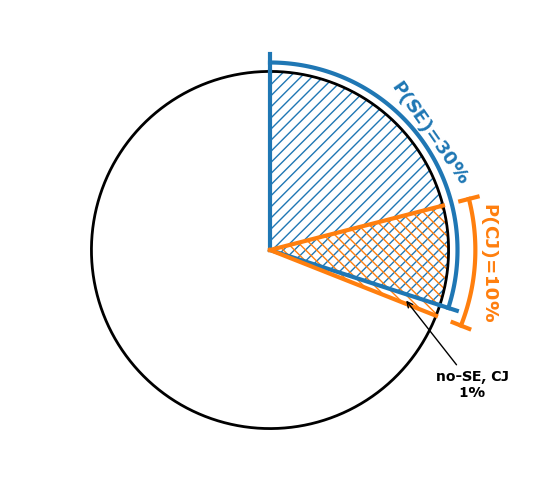
What we learn from multi-planet systems?
- Orbital properties of planets in the same system are correlated \(\longrightarrow\) Dynamical evolution may have largely reshaped the system architecture.
- The existences of planets in the same system are correlated \(\longrightarrow\) Planet formation is a global behaviour.
- Physical properties of planets in the same system are (largely) not correlated \(\longrightarrow\) Planet formation usually yields a diversity of planets.
- Future prospects:
- TESS+Gaia to study the architecture of hundreds of multi-planet systems (e.g., pi Mensae, Xuan & Wyatt 2020, Damasso et al. 2020, De Rosa et al. 2020).
- Young multi-planet systems.
- Linking to cold Neptunes via microlensing surveys (e.g., Roman microlensing).

What we learn from multi-planet systems?
- Orbital eccentricities, mutual inclinations, and spacings all depend on the multiplicity, suggesting that the dynamical evolution may have reshaped the system architecture.
- Systems with more planets are dynamically colder.
- The inner (<1 AU) and the outer (~1-10 AU) planetary systems are strongly correlated, indicating that planet formation is a global behavior.
- This inner-outer correlation unexpected in theories of Kepler planet formation.
- Implications to Solar system-like architecture.
- Future prospects:
- Young multi-planet systems.
- Combining different detection techniques (e.g., transit, RV, astrometry, microlensing).
What we learn from multi-planet systems?
- Orbital eccentricities, mutual inclinations, and spacings all depend on the multiplicity, suggesting that the dynamical evolution may have reshaped the system architecture.
- Systems with more planets are dynamically colder.
-
The inner (<1 AU) and the outer (~1-10 AU) planetary systems are strongly correlated. This inner-outer correlation unexpected in theories of Kepler planet formation.
- Implications to Solar system-like architecture.
- Future prospects:
- TESS+Gaia to study the architecture of hundreds of multi-planet systems (e.g., pi Mensae, Xuan & Wyatt 2020, Damasso et al. 2020, De Rosa et al. 2020).
- Young multi-planet systems.
- Linking to cold Neptunes via microlensing surveys (e.g., Roman microlensing).

- Nearly half of Kepler planets found in systems w/ one transiting planets.
- E.g., Thompson et al. (2018), Xie et al. (2016), Berger et al. (2018, 2020).
- Transit singles & transit multis have statistical similar properties.
- E.g., Xie et al. (2016), Munoz Romero & Kempton (2018), Zhu et al. (2018), Weiss et al. (2018).
(Kepler planets around Sun-like stars, based on Kepler DR25 & Gaia parameters)
Talk outline
- Introduction, job ad, & outline (3 slides)
-
Inner multiplicity
- Mutual inclination distribution and the "Kepler dichotomy" (3 slides & refer to He talk).
- what it means, the issue, the solution (and possibly others).
- Kepler planets are dynamically compact and the eccentricity distribution (3 slides).
- period ratio distribution, dynamical spacing, interpretation.
- On the apparent correlation in planetary sizes (3 slides).
- the observation, the potential issues (two-fold).
- Mutual inclination distribution and the "Kepler dichotomy" (3 slides & refer to He talk).
-
Global multiplicity
- Hot Jupiters are lonely & friends of hot Jupiters (3 slides).
- HJ & SE, HJ & CJ, the interpretation.
- Super Earth-cold Jupiter correlation (3 slides).
- Observations (RV & transit), the theoretical implication.
- Microlensing FFPs are probably dynamically ejected planets from multi-planet systems (1-2 slides & refer to Mroz talk).
- Hot Jupiters are lonely & friends of hot Jupiters (3 slides).
-
Future prospects
- Gaia+TESS (or other transit surveys) enabling further architecture studies (1-2 slides).
- Multi-planet systems around younger stars to study how the dynamical evolution works. Briefly mention about direct imaging (1 slide).
- Roman microlensing survey as a link to the cold Neptune population (1 slide & refer to several other ulensing talks).

0.4 \(R_\oplus\)
0.9 \(R_\oplus\)
1.0 \(R_\oplus\)
0.5 \(R_\oplus\)
11 \(R_\oplus\)
9 \(R_\oplus\)
4.0 \(R_\oplus\)
3.9 \(R_\oplus\)
On the intra-system variation: Do Solar system planets show size (or mass) similarity?
- No, if knowing all planets
- Giant planets are not observable: orbital period too long
- Mercury & Mars undetectable: too small
- Yes, if only Venus & Earth are seen
See Zhu (2020) and Murchikova & Tremaine (2020).